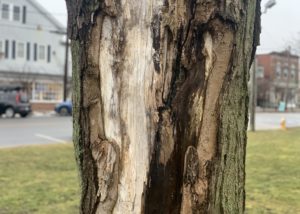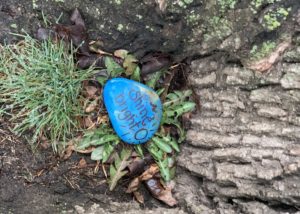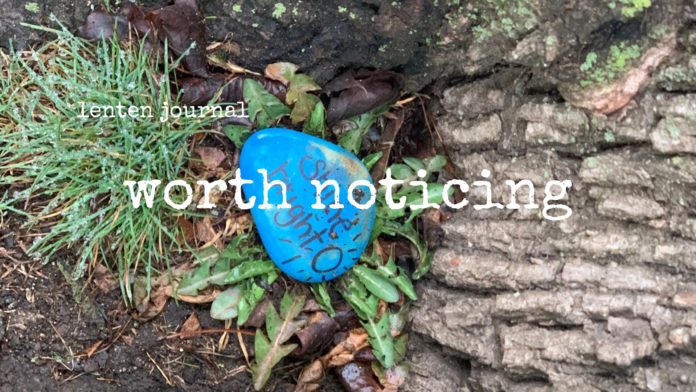On Thursday morning I walk across the Green to meet my friend Peter for coffee at Cilantro, the one coffee shop that opens at 7. I follow the sidewalk down the center and then take the spoke that gets me to the crosswalk and then to coffee and friendship. Peter and I have been meeting for at least five years now, I think, and I’ve made the same walk there and back each week, with a few gaps in the calendar here and there.
This time of year, the days have gotten long enough where it is daylight while I walk–at least until Daylight Saving Time kicks in and I go back into the dark. I walk past the same light posts, past the monument to our soldiers who fought in the Civil War, past the town Christmas tree, and past a whole bunch of trees that line the sidewalks, some tall and old and others young and aspiring.
I pay better attention on my walk home because I have been stirred to life by good coffee and conversation, and also because of The Art of Noticing, a book I first read two or three years ago that offers ways on paying better attention to the world around us. One of the exercises is to take the same walk several times and notice tree bark.
The first section of sidewalk is lined with big trees on one side and close to a giant weeping  willow on the other. The first tree looked wounded, as though a large piece of bark had been stripped away. It left strata of shades of brown and green that ran vertically like a mine turned sideways. The array of colors looked like ages. The light section felt like new wood and little dimension. The darker ones felt deep and ancient, as though I was looking through a dimension into something more profound.
willow on the other. The first tree looked wounded, as though a large piece of bark had been stripped away. It left strata of shades of brown and green that ran vertically like a mine turned sideways. The array of colors looked like ages. The light section felt like new wood and little dimension. The darker ones felt deep and ancient, as though I was looking through a dimension into something more profound.
When I got to the second tree, my eye caught a painted stone lying at the base of the tree with the words “shine bright” written on its face. It was nestled in curve of the trunk where it entered the earth. A plant had begun to grow underneath the stone and a tuft of grass  was growing next to it. I took a picture and then put my phone in my pocket and just stood and looked to see what I could see.
was growing next to it. I took a picture and then put my phone in my pocket and just stood and looked to see what I could see.
The scene turned into a tiny landscape. The bark to the right began to look like a dry waterfall that fed the vegetation and the flatter section dotted with lichen became a granite outcropping like those I see along the highway.
So much more is going on that what we see.
Sometime before the pandemic, Kindness Stones were a thing in Guilford, as I am sure they were in many other places. Brightly painted stones with gentle messages showed up all over town on doorsteps, along sidewalks, in trees, on window sills–all of them inviting the finder to carry it with them along with the message. They are rarer these days, so the tiny blue boulder of blessing stood out and also opened a mystery as to who put it at the base of a hundred year old tree and why.
I continued home in the dampness of yet another chilly and cloudy day, the mist attaching to my sweater as if to say I was not simply an observer; I, too, was part of the scene, part of what was worth noticing.
I went on about my day, first to the gym and then to church and then to visit some folks that can’t get to church right now for health reasons. I went so they would know we missed them. They welcomed me with pie and coffee, so I had a meal-sized piece of apple pie for lunch. The drive back to Guilford is mostly by interstate, the great highway of inattentiveness, where we fly by all sorts of things. When I got home, the same mist marked me once again as a part of the scene. Our waiting pups barked belonging from behind the gate–another bark worth noticing.
It was a good day, as far as I could see.
Peace,
Milton

♥️♥️♥️♥️♥️♥️
Your writing feels like a tiny boulder of blessings. Today I will try to notice all the gifts I might have missed. Thank you Milton.
I agree with Wynne. This prose was poetry.